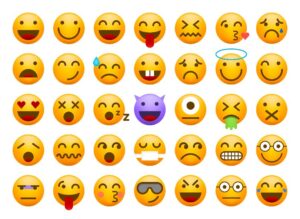By Rose O. Sherman, EdD, RN, NEA-BC, FAAN
 A nurse manager shared the story: “I love to use emojis in my texts to staff. I recently sent a thumbs-up
A nurse manager shared the story: “I love to use emojis in my texts to staff. I recently sent a thumbs-up![]() emoji to one of my staff to congratulate her on a well-done job. It had quite the opposite effect when she told me that a thumbs-up emoji is passive-aggressive in her world. I checked with some of my younger staff, and they validated that my use of emojis was sometimes annoying and the emoji had a different meaning for me than their perceptions. Boy, was I ever surprised. Communication does change over time. Some days, I feel like I am working in a foreign country with my younger nurses – so different from me.
emoji to one of my staff to congratulate her on a well-done job. It had quite the opposite effect when she told me that a thumbs-up emoji is passive-aggressive in her world. I checked with some of my younger staff, and they validated that my use of emojis was sometimes annoying and the emoji had a different meaning for me than their perceptions. Boy, was I ever surprised. Communication does change over time. Some days, I feel like I am working in a foreign country with my younger nurses – so different from me.
This nurse manager is not alone. There have recently been articles in the press about how emojis may mean different things to different generations. According to the New York Post, a study by Perspectus Global of over 2,000 people aged 16 to 29 revealed ten emojis that are, as the New York Post puts it, “canceled.” The emojis include: Thumbs-up 👍, red heart ❤️, “OK” hand 👌, checkmark ✅, poo 💩, loud crying face 😭, monkey covering eyes 🙈, clapping hands 👏, lipstick kiss mark 💋 and grimacing face 😬. Most Generation Z believe you are “officially old” if you use a thumbs-up or heart emoji.
No one is suggesting that you completely abandon the use of emojis, but understanding generational preferences and how meaning is assigned is crucial, as it is in any communication. One manager told me she put together a sheet of emojis she often used and gave it to individual staff, asking what emotion the emoji conveyed to them. She found it was not a one size fits all approach.
Author Erica Dhawan points out that emojis provide texture and context to digital communication in the same way body language does when we are in face-to-face communication. Humans send out 6 billion emojis daily, with the average person sending out 96 emojis over 24 hours. They have become an essential shortcut in communication. Dhawan warns if clarity is your goal in communicating, you should recognize that emojis may not be as universal as you believe. You need to tailor it to the audience. A baby boomer might take the thumbs up in the manner that it was intended, but a Generation Z nurse might see it differently.
As is true of many things in leadership, you don’t know how your communication is received unless you ask for feedback. So before you include that next emoji, think about your audience.
Read to Lead
Dhawan, C. (2021). Digital body language: How to build trust and connection, no matter the distance. New York: St. Martins Press.
© emergingrnleader.com 2022
Book your 2023 Leadership Development Programs Now – Two New Programs Available Virtual or Onsite – For Nurses and Other Healthcare Leaders
From Traditional Nurse Leader to Nurse Leader Coach – Click Here for the Flyer
Rebuilding Your Nursing Team in 2023: Coming Together after Falling Apart – Click Here for the Flyer
Our Most Popular Right Now – Nurse Recruitment and Retention in Turbulent Times – Click Here for the Retention WS Flyer
For new leaders and emerging leaders consider doing The Nuts and Bolts of Nursing Leadership Program – Click Here for the Nuts and Bolts Flyer Final
Read the Nurse Leader Coach – Available at Amazon and Other Book Sellers
Recommended Book by the Association of Critical Care Nurses – The Nuts and Bolts of Nursing Leadership: Your Toolkit for Success



 LinkedIn
LinkedIn Instagram
Instagram